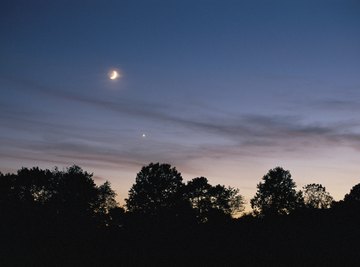
People throughout the ages have appreciated the beauty of Venus, frequently the brightest object in the sky at dusk and dawn. The planet, named after the Roman goddess of art and beauty, can actually be bright enough to cast shadows on a moonless night. It appears so close to the sun because its orbital radius is smaller than the Earth's, and because it also moves faster than Earth, its orbital period is shorter.
The Morning and Evening Star
The fact that Venus can appear as either the morning star or the evening star prompted the ancients to give it two different names, because they thought it was two different planets. It spends about 263 days as Phosphoros, the ancient Greek name for the morning star, and an equal time as Hesperos, the evening star. In between, it disappears for stretches of 8 to 50 days. These phenomena are due to the combined effect of the orbits of Venus and Earth around the sun. The sidereal period of Venus, which is the time it takes to orbit the sun, is about two-thirds that of Earth.
The Phases of Venus
Because Venus has an orbit smaller than Earth's, it displays phases in the same way the moon does, although no one knew this until Galileo observed it in 1610. His observations of Venus helped put to rest the notion of an Earth-centered universe. When it is on the side of the sun farthest from Earth, it appears full, although dimmer because of its distance. It becomes crescent-shaped while nearing and retreating from its closest approach to Earth. When it is on the same side of the sun as Earth, it appears larger and brighter, but it is only a thin crescent.
Sidereal and Rotational Periods
The period of rotation of Venus is 243 Earth days, which is longer than the 225 days it takes the planet to orbit the sun. Moreover, the rotation is in the opposite direction from other planets in the solar system. On Venus, the sun rises in the west and sets in the east. It would be difficult to observe either a sunrise or sunset, however, because the thick atmosphere of carbon dioxide and nitrogen, with its swirling clouds of sulfuric acid, undoubtedly prevents a clear view. The atmospheric pressure on the surface is 90 times that of Earth's surface.
Earth's Sister Planet
Venus is almost the same size as Earth, but slightly smaller, and has the same general composition. Its orbit is closer to the Earth than that of any other planet, and both have young surfaces and thick clouds. The motions of this planet, which is as close to a twin as Earth will ever have, have helped astronomers calculate the distance from the Earth to the sun and have inspired legends. For example, the progressive brightening of the evening star, its sudden disappearance and rebirth as the morning star after an eight-day period are personified in the journey of Quetzalcoatl, the Feathered Serpent of the ancient Mayans.
References
About the Author
Chris Deziel holds a Bachelor's degree in physics and a Master's degree in Humanities, He has taught science, math and English at the university level, both in his native Canada and in Japan. He began writing online in 2010, offering information in scientific, cultural and practical topics. His writing covers science, math and home improvement and design, as well as religion and the oriental healing arts.
Photo Credits
Comstock/Comstock/Getty Images
